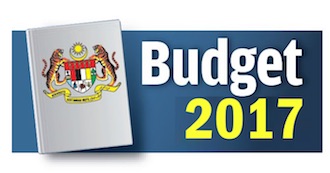Malaysia hopes for faster growth, lower budget deficit in 2017

(Reuters) – Malaysia is banking on domestic demand and a recovery in global commodities prices to help it grow slightly faster in 2017 and reduce its large budget deficit.
The government projects that Southeast Asia’s third-largest economy should grow 4-5 per cent next year. In January, it had to slash its 2016 budget lower this year’s growth forecast to 4.0-4.5 per cent as revenue plummeted when oil fell to US$30 (RM126) a barrel.
The forecast was contained in the government’s annual economic report, which was released just ahead of Prime Minister Najib Razak’s announcement of the 2017 budget.
“We will continue to ensure economic indicators — such as inflation levels, growth rates and debt levels — remain strong and resilient, reflecting the core fundamentals of the economy,” Najib said yesterday.
Malaysia’s current account surplus is expected to shrink further — narrowing to RM14.8 billion in 2017 from RM16.4 billion this year and RM34.7 billion in 2015.
The government led by Najib, who might call an early election in 2017, forecast a budget deficit to RM40.3 billion or 3 per cent of GDP for the coming year.
That would be a slight improvement on the 3.1 per cent target for 2016. But in the first half of this year, the budget deficit reached 5.6 per cent. Ratings agencies have warned of a possible downgrade if the budget deficit is too large.
Global oil prices have recovered somewhat this year amid expectations that Opec-member countries will agree on a production cut at a meeting scheduled for Nov. 30.
The global price is important to Malaysia, which exports oil and natural gas, and the higher oil level has buoyed the ringgit currency, which hit its strongest level in over a week yesterday.
Stronger exports seen
In 2017, government revenue is seen rising by 3.4 per cent to RM219.7 billion next year, after a decline of 3 per cent this year, as higher tax collections, including RM40 billion expected from the goods and services tax (GST), offsets a drop in oil revenue.
The economic report says demand in the private sector will be a key driver of the economy in 2017, and will be supported by “pro-growth fiscal and accommodative monetary policies” and a stable inflation rate of between 2 and 3 per cent.
The government also sees expansion across all five of its key sectors — services, manufacturing, agriculture, mining and construction — on expectation that gross exports will grow 2.7 per cent in 2017, compared with the projected 1.1 per cent rate this year.
Leading the exports push will be a projected 4.1 per cent expansion in manufacturing, largely supported by sustained demand for electrical and electronic goods.
The world’s second-largest exporter of natural gas expects to reverse the decline in liquefied natural gas (LNG) exports once the Petronas floating LNG 1 rig comes online next year, adding 1.2 million tonnes to annual production to push a 1.4 per cent expansion in total output.
The government also expects agriculture to grow by 1.5 per cent in 2017 after a projected contraction of 3.3 per cent this year, as demand for oil palm and rubber is seen improving.
Total government debt is expected to go down to 53.2 per cent of GDP this year. In 2015, government debt was at 54.5 per cent, just shy of Malaysia’s 55 per cent debt ceiling.

